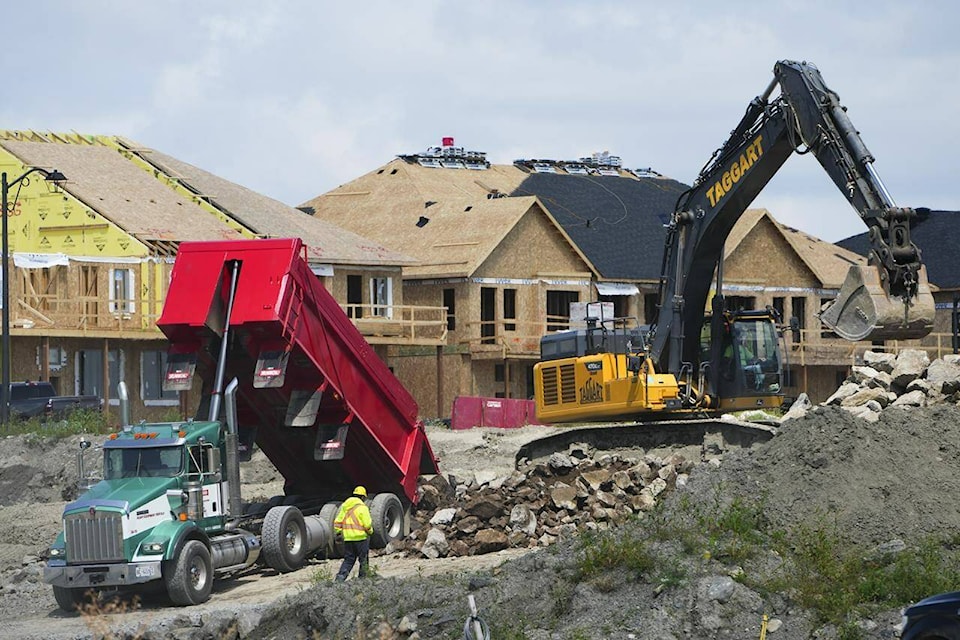Despite housing starts in Canada’s six largest citieshovering at near all-time highs last year, experts warn those levels are still not enough to address the country’s housing shortage in the years to come.
The Canada Mortgage and Housing Corp.’s biannual housing supply report released Wednesday showed construction began on 137,915 new units last year across the Toronto, Vancouver, Montreal, Calgary, Edmonton and Ottawa regions.
That represented a 0.5 per cent dip compared with 2022, but the figures remained in line with the annual average of around 140,000 new units over the past three years. The agency attributed stability to a surge of new apartments, though demand is still outpacing supply for rental housing.
CMHC deputy chief economist Aled ab Iorwerth said the 2023 numbers came in “better than we thought.”
“We ended up being positively surprised by 2023. We were really quite concerned that higher interest rates were going to really have an impact,” said ab Iorwerth.
“They did have an impact, but it seems to have been on smaller structures, single-detached (homes) and so forth.”
Apartment starts grew seven per cent to reach a record 98,774 individual units last year. However, those gains were offset by declines in the number of new single-detached homes, which fell 20 per cent year-over-year, due to weaker demand for higher-priced homes in an elevated mortgage rate environment.
The agency continued to warn about the need to ramp up housing construction to address affordability gaps and significant population growth in Canada.
“It’s definitely not adequate,” said Western University associate professor Diana Mok, who studies real estate economics.
“While supply is increasing in the last year or so, population is also increasing. So the demand for rental units is also increasing, while rents are not coming quite down yet.”
Mok said the figures represent a “snapshot of what happened in the past” — namely construction projects that were planned two to three years ago before interest rates began skyrocketing.
She cautioned last year’s high housing start levels may be temporary “because the whole impact of higher interest rates has not been felt yet.”
“It’s something that we can celebrate,” said Mok. “It is still a long way to go.”
The CMHC said housing starts are projected to decrease in 2024, despite its forecast that Canada will require an additional 3.5 million units by 2030, on top of what is currently projected to be built, to restore affordability to levels seen around 2004.
Its report cited rising costs, larger project sizes and labour shortages last year that led to longer construction timelines, prompting various levels of government in Canada to announce new programs aimed at stimulating new rental housing supply.
“We’re still not building enough, particularly on the rental side,” said ab Iorwerth.
“The demand is enormous. I don’t think we’re keeping up with demand. So we need a lot more investment.”
While high interest rates have cooled demand for home purchases, as many buyers stayed on the sidelines last year, the impact was not only reflected by the decline of single-detached starts. Ab Iorwerth said higher rates also make it less attractive to build new rental structures.
“One of the issues with building a rental structure is the cost of the building has to be borrowed. Obviously, the rental income is in the future, but the cost of construction is today,” he said.
“The cost of construction has to be borrowed from various financial institutions and so as interest rates have gone up, it’s been harder, more costly to get access to that financing to build rentals.”
Of the six cities examined, Vancouver, Calgary and Toronto saw growth in their total starts, driven by new apartment construction reaching record highs.
Vancouver had a record 33,244 new housing starts in 2023, a 27.9 per cent gain from the previous year, followed by Calgary’s 19,579 new homes built, a 13.1 per cent increase.
There were 47,428 housing starts in Toronto, marking a 5.1 per cent rise, but ab Iorwerth noted those levels were “concerning” as the proportion of apartment starts designated as rentals was just 26 per cent — the lowest of any region.
Montreal, Ottawa and Edmonton recorded declines in total housing starts from the previous year. The report said Montreal, at 36.9 per cent fewer homes built, was the only market with a significant decrease across all housing types.
With 15,235 housing starts last year, the Montreal figures partially reflected labour shortages and supply chain problems, said ab Iorwerth, who added the city is more vulnerable to high interest rates than other cities studied.
“The buildings tend to be a little bit smaller in Montreal and so the housing starts react more quickly to higher interest rates, meaning it’s a quicker turnaround on smaller structures,” he said.
“It’s possible that Montreal has reacted faster to the hike in interest rates.”
Ottawa saw 9,245 new homes built last year, which marked a 19.5 per cent decrease from 2022, while there were 13,184 housing starts in Edmonton, a 9.6 per cent decline.
READ ALSO: Canadian housing starts up 14% in January
